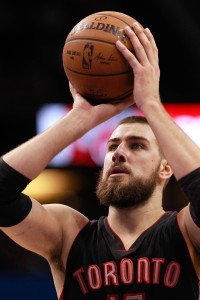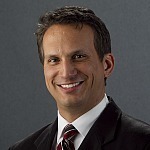No one who’s a part of the Raptors core was as highly drafted as Jonas Valanciunas, the No. 5 pick from 2011. Toronto had to wait a year for the Lithuanian center while he continued to play overseas, but he’s quickly established himself as an NBA starter in the three seasons since. It’s convincing the Raptors that he can finish games that has proven troublesome for the 7-footer, who often sat on the bench in crunch time this past season, one in which he played a relatively meager 26.2 minutes per game despite starting in all 80 of his regular season appearances. The Raptors reportedly want an extension with him, and while that’s no surprise, GM Masai Ujiri surely has a ceiling for negotiations with a center who saw the floor for barely more than half the game.
Still, Ujiri called Valanciunas “a huge part of our team” at season’s end, adding that the way the team deployed the center this past season would be a “big discussion” he would have with coach Dwane Casey and his staff. Valanciunas appeared to stagnate this past season after a leap between his rookie and sophomore years, and that was a factor in the changes that ultimately took place to Casey’s staff, as Ken Berger of CBSSports.com reported a few months ago. All of that would suggest that Ujiri feels Valanciunas is capable of playing more minutes and finishing more games than he did in 2014/15, which bodes well for the Leon Rose client as extension talks loom.
The problem lies on defense. The Raptors were a better defensive team when Valanciunas sat than when he played last season, by a measure of 1.6 points per 100 possessions, as NBA.com shows. He was a minus defender, according to Basketball-Reference’s Box Plus Minus. Those are serious issues for any NBA starting center, let alone one whom a team is considering for a long-term commitment. ESPN’s Real Plus Minus is kinder, ranking him as the 33rd-best defensive center, two spots behind fellow rookie scale extension candidate John Henson, whom other defensive metrics love, as I examined earlier. A ranking of No. 33 among centers is cold comfort, nonetheless. Casey’s forte is defense, but he’ll have to work some true wizardry to give the Raptors a championship-level defense any time soon unless Valanciunas can improve on that end.
Ujiri made moves to improve the team’s defense this past season, none more striking than his four-year, $58MM deal for three-and-D forward DeMarre Carroll. He also brought in Bismack Biyombo, a defensive specialist, to play as the backup to Valanciunas. Biyombo, who averaged only 4.8 points per game last season, would be the only logical alternative for Casey if he doesn’t want Valanciunas on the floor down the stretch, so unless the Raptors merely want to protect a lead, it seems likely that Valanciunas will be on the floor when the final horn sounds.
The 23-year-old has shown he’s capable of getting better in other regards. His PER vaulted from 16.1 in 2013/14 to a strong 20.6 this past season, a sign that he made the most of his time on the floor. Indeed, Valanciunas scored more points per game in fewer minutes and on slightly fewer shots. He made a career-best 57.2% of his attempts from the floor, upping the percentage of his shots that came at point-blank range, as Basketball-Reference shows. He’s also become a better rebounder, having averaged nearly 12 rebounds per 36 minutes this past season after he started out at just 9.0 in the per-36 category as a rookie.
Next year’s free agent class is relatively thin after the top few names, but the available centers are fairly intriguing. Andre Drummond seems destined to either receive an extension from the Pistons or re-sign next summer, but Dwight Howard and Pau Gasol can opt out. Former Florida teammates Al Horford and Joakim Noah figure to be highly sought-after, as does Al Jefferson. Hassan Whiteside will have no shortage of suitors if he duplicates his breakthrough year for the Heat, and Roy Hibbert can vault himself into the upper tier with a bounceback season for the Lakers. Teams will have serious money to throw around, with the salary cap set to surge to $89MM, but Valanciunas will have competition for it.
The Raptors can go in several different directions. They only have about $42MM in salary commitments for 2016/17 as it stands, though that figure will almost certainly rise to approximately $45.5MM when Toronto picks up its team options on Lucas Nogueira and Bruno Caboclo. Early word indicates that DeMar DeRozan will opt out, and Terrence Ross, like Valanciunas, can hit restricted free agency if he doesn’t receive an extension. Re-signing DeRozan, Ross and Valanciunas at market value would likely leave the team without the capacity to chase top-tier free agents next summer, when Toronto native Tristan Thompson would be an unrestricted free agent if he signs his qualifying offer.
I speculated in our Raptors offseason outlook that Valanciunas and Rose would ask for $12MM salaries that would put him in line with what Nikola Vucevic, another defensively challenged starting center, received on his extension from the Magic last year. The spending in this summer’s free agent market, including a max deal of more than $17.5MM a year for defensive sieve Enes Kanter and Ujiri’s commitment of a $14.5MM average annual value to Carroll, suggests that $12MM is too low a starting point. The Valanciunas camp will probably ask for at least as much as Carroll received, and I wouldn’t be surprised to see the center ultimately end up with $13-14MM a year, numbers that look high but are well beneath the projected $20.4MM max for players with his level of experience.
That may end up a bargain if Casey and new assistants Rex Kalamian, Andy Greer and Jerry Stackhouse turn Valanciunas into a credible defender and continue his offensive development. Ujiri appears to have no shortage of faith that Valanciunas will improve and seems to view him as a cornerstone for the future. That’s probably enough motivation for Toronto to make an offer lucrative enough to get a deal done this fall.
How much do you think Valanciunas should make per year on his next deal? Leave a comment to tell us.


